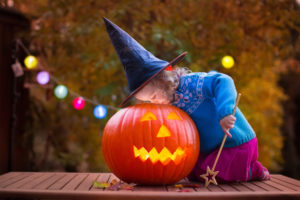October 16, 2017 | Black & Kletz Allergy

You may have never pondered about the connection between Halloween and allergies and you would not be alone. Unfortunately, approximately 8% of all children in the U.S. have some type of food allergy. These kids and their families are generally the only ones who connect this cheerful holiday with food allergies. There is a good reason for this as food allergies can be very serious and in some cases fatal. Almost 40% of children with food allergies have had a severe reaction to a food. About 30% of children with food allergies have multiple food allergies. According to Centers for Disease Control and Prevention (CDC), food allergies in children have increased by 50% between the years 1997 and 2011. Peanut is the most common food allergy in children followed by milk. The other 6 foods that are in the top 8 most allergic foods, (in addition to peanut and milk mentioned above) include shellfish, tree nuts, soy, wheat, eggs, and fish. These 8 foods account for 90% of all food allergy reactions. It is not surprising that Halloween candy often contains 6 of the 8 most common food allergens. You guessed it, fish and shellfish are generally not a problem in Halloween candy, however, peanuts, tree nuts, milk products, soy, eggs, and/or wheat are found in a multitude of Halloween candy. It is important to note that in some cases, miniaturized candies often given out during Halloween may contain different ingredients than their full-sized versions. In addition, many miniaturized candies do not have labels which make it nearly impossible for the parents to deem the candy safe for their child.
What can be done to insure that a “food allergic” child can participate in Halloween and have as much fun as the next child? Nothing is guaranteed, however, there is a program run by the Food Allergy Research and Education (FARE) organization called the “Teal Pumpkin Project”. This FARE-sponsored international program has been around since 2014. It began in Tennessee, however, as a local crusade in 2012 by the mother of a severely food allergic child. She also created a food allergy support group called the Food Allergy Community of East Tennessee (FACET).
The Teal Pumpkin Project’s aim is to raise awareness of the severity of food allergies and show support to families who have a food allergic child. This is accomplished by painting a pumpkin teal and placing it on one’s front porch to signify that non-food treats are available at that location on Halloween night. The color teal was used because it represents food allergy awareness. Typically, non-food treats may include toys, stickers, crayons, glow sticks, hair accessories, rings, bracelets, necklaces, coins, bookmarks, spider rings, vampire fangs, whistles, balls, finger puppets, etc.
Another important point is to clarify that the Teal Pumpkin Project is not exclusionary and it still promotes the option of giving out normal trick-or-treat candy to children without food allergies. It recommends that the non-food items be kept in a different bowl than the traditional candy bowl. FARE provides a “Teal Pumpkin Project Participation Map” on its website so that participating houses can be easily assessed by the parents of food allergic children.
The board certified allergists at Black & Kletz Allergy support the efforts of FARE’s Teal Pumpkin Project and hope that our patients will continue to expand this endeavor. We have always had a link, on the upper portion of our website under the blue “Resources” tab, to the Food Allergy Research Education (FARE) organization. If you or your child suffer from food allergies, food intolerances, or eosinophilic esophagitis, please call us to make an appointment. Alternatively, you can click Request an Appointment and we will respond within 24 hours by the next business day. Black & Kletz Allergy has offices in Washington, DC, McLean, VA (Tysons Corner, VA), and Manassas with on-site parking all 3 locations. Our Washington, DC and McLean, VA locations are Metro accessible and we offer a free shuttle between our McLean, VA office and the Spring Hill metro station on the silver line. We look forward to helping you with all your allergy, asthma, and immunology needs as we have been doing in the Washington, DC, Northern Virginia, and Maryland metropolitan area for more than a half century.












